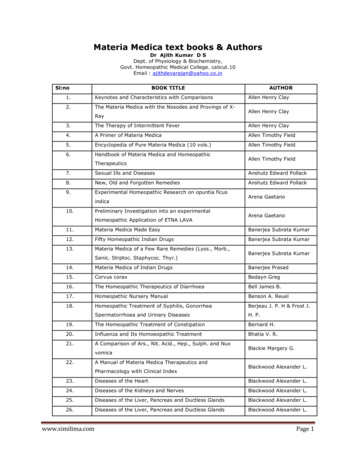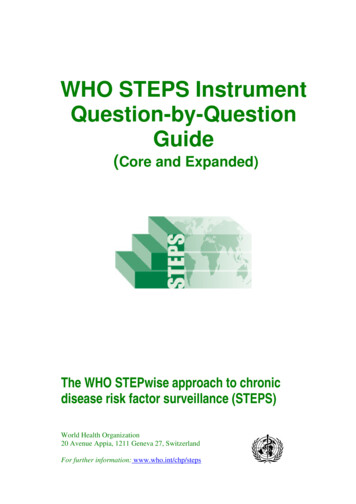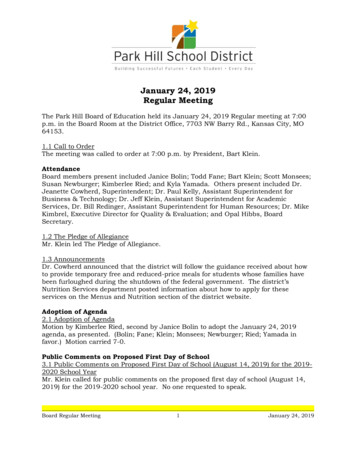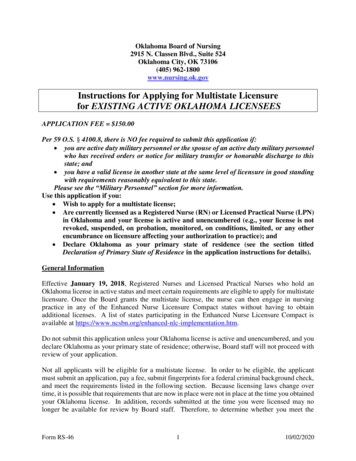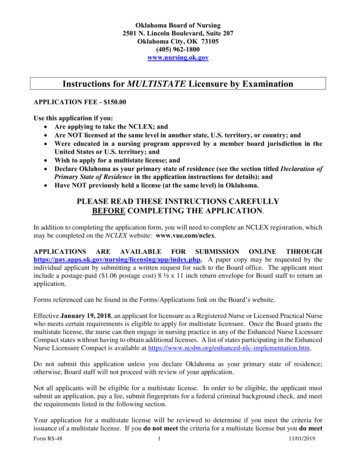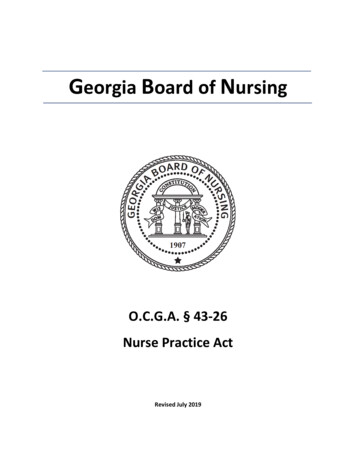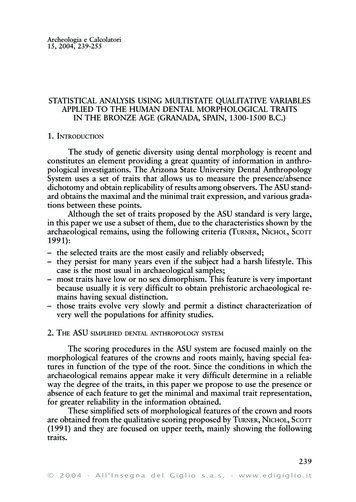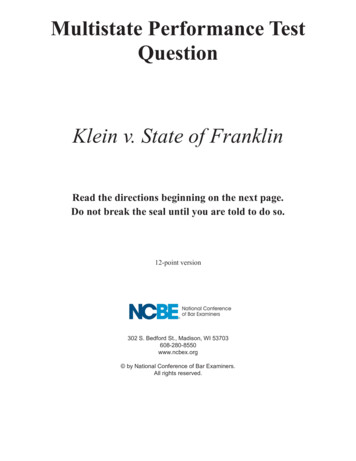
Transcription
Multistate Performance TestQuestionKlein v. State of FranklinRead the directions beginning on the next page.Do not break the seal until you are told to do so.12-point version302 S. Bedford St., Madison, WI 53703608-280-8550www.ncbex.org by National Conference of Bar Examiners.All rights reserved.
MULTISTATE PERFORMANCE TEST QUESTIONNCBE COPYRIGHT NOTICE AND PENALTIESBy beginning the timed testing session, I certify that my purpose in taking this Multistate PerformanceTest (MPT) question is for admission to the bar and for no other purpose.I further affirm and agree that I will not copy or otherwise reproduce this MPT question or answer.Likewise, I will not disclose, in whole or in part, this MPT question or answer to any party during orafter the examination, whether orally, in writing, electronically, or otherwise. I recognize andacknowledge that this MPT question is protected by US copyright laws, and that any unauthorizeddisclosure of its contents—in whole or in part—could result in civil liability, criminal penalties,cancellation of my test scores, denial of my bar application on character and fitness grounds, and/orother sanctions, including disciplinary action if I have been admitted to practice law.NCBE DATA USETesting data, including personally identifiable information, test responses, test performance data such askeystrokes and time spent on each item, and misconduct and other reports, will be shared with NCBEfor statistical, research, exam security, and other purposes. Data will be held by NCBE in accordancewith the NCBE Privacy Policy posted on the NCBE website (http://www.ncbex.org/privacy-policy/).After the test administration, NCBE may contact you via email to participate in a survey regarding yourtesting experience.NCBE LIMITATION OF LIABILITYIn the unlikely event that any error or mistake occurs in test registration, test administration or delivery,scoring, or score reporting, a remedy, if any, will be determined and provided under the exclusiveauthority and discretion of your jurisdiction. NCBE is not responsible for any errors or mistakes thatoccur relating to test registration, test administration or delivery, the scoring of any tests, and/or thereporting of test scores.Directions - Page 1
DIRECTIONSYou will be instructed when to begin and when to stop this test. Do not break the seal on this bookletuntil you are told to begin. This test is designed to evaluate your ability to handle a select number oflegal authorities in the context of a factual problem involving a client.The problem is set in the fictitious state of Franklin, in the fictitious Fifteenth Circuit of the UnitedStates. Columbia and Olympia are also fictitious states in the Fifteenth Circuit. In Franklin, the trialcourt of general jurisdiction is the District Court, the intermediate appellate court is the Court of Appeal,and the highest court is the Supreme Court.You will have two kinds of materials with which to work: a File and a Library. The first document in theFile is a memorandum containing the instructions for the task you are to complete. The other documentsin the File contain factual information about your case and may include some facts that are not relevant.The Library contains the legal authorities needed to complete the task and may also include someauthorities that are not relevant. Any cases may be real, modified, or written solely for the purpose ofthis examination. If the cases appear familiar to you, do not assume that they are precisely the same asyou have read before. Read them thoroughly, as if they all were new to you. You should assume that thecases were decided in the jurisdictions and on the dates shown. In citing cases from the Library, you mayuse abbreviations and omit page references.Your response must be written in the answer book provided. If you are using a laptop computer toanswer the questions, your jurisdiction will provide you with specific instructions. In answering thisperformance test, you should concentrate on the materials in the File and Library. What you havelearned in law school and elsewhere provides the general background for analyzing the problem; the Fileand Library provide the specific materials with which you must work.Although there are no restrictions on how you apportion your time, you should allocate approximatelyhalf your time to reading and digesting the materials and to organizing your answer before you beginwriting it. You may make notes anywhere in the test materials; blank pages are provided at the end ofthe booklet. You may not tear pages from the question booklet.Do not include your actual name anywhere in the work product required by the task memorandum.This performance test will be graded on your responsiveness to the instructions regarding the task youare to complete, which are given to you in the first memorandum in the File, and on the content,thoroughness, and organization of your response.Directions - Page 2
This page intentionally left blank.
This page intentionally left blank.
Klein v. State of FranklinFILEMemorandum to examinee.1Certified letter from Janet Klein.2Traffic collision report.4Memorandum from Ernest Thomas .5LIBRARYExcerpts from Franklin Tort Claims Act.9Rodriguez v. Town of Cottonwood, Franklin Court of Appeal (2018).10Farrington v. Valley County, Franklin Supreme Court (2015).12Beck v. City of Poplar, Franklin Supreme Court (2013).14i
This page intentionally left blank.
FILE
This page intentionally left blank.
MEMORANDUMTo:From:Re:Law Offices of Bunke & Huss600 Center Street, Suite 210Franklin City, Franklin 33113ExamineeGeorge BunkeJanet Klein matterJanet Klein met with me last week about a potential claim she has against the State ofFranklin for the actions of Randall Small as a State employee, for injuries Ms. Klein suffered in acar accident at the Franklin State Fairgrounds on May 23, 2020, the Saturday of Memorial Dayweekend. As you know, governmental entities and governmental employees typically cannot besued because of sovereign (or governmental) immunity. In Franklin, the Franklin Tort Claims Actwaives sovereign immunity in certain circumstances. The Franklin Tort Claims Act also providesspecific notice requirements for bringing suit against a governmental entity. If the State did notreceive notice within the required time frame, Ms. Klein cannot pursue a claim against the Stateor Mr. Small.I would like you to prepare an objective memorandum to me analyzing two issues:1. Is the State of Franklin protected from liability in this case by sovereign immunity?2. Did the State of Franklin receive sufficient notice as required by the Franklin TortClaims Act?You should address both issues in your memorandum regardless of your conclusion asto each one. For each issue, be sure to explain your analysis, cite relevant legal authority, andstate your conclusion. Do not include a separate statement of facts, but be sure to incorporate therelevant facts, analyze the applicable legal authorities, and explain how the facts and law affectyour analysis.Because Mr. Small is a State employee, the State of Franklin is vicariously liable forany negligence committed by Mr. Small in the scope of his employment. For purposes of yourmemorandum, assume that Mr. Small was negligent and acting within the scope of his employmentand that if the State is found to have waived its immunity, his negligence will be imputed to theState.1
SENT BY CERTIFIED MAILAugust 30, 2020Janet Klein512 Lake Ave.Franklin City, FR 33105Risk Management DivisionState of Franklin Office Building448 Central Ave.Franklin City, FR 33113To Whom It May Concern:I am writing to give you official “notice” that I will be suing the State of Franklin for injuries Isuffered in a three-car collision at the Franklin State Fairgrounds while exiting after the HoppsRodeo. This tragic accident resulted from the State’s negligence. My car was simultaneously hitby two other cars—one car rear-ended mine and the other hit my passenger-side rear door.Because of the accident, I suffered a serious back injury and a broken wrist. My 2017 ToyotaCorolla was damaged. I had to pay the 500 auto insurance deductible to have it repaired. I alsomissed three weeks of work due to my injuries. I am a physical therapist and could not providefull therapy services because of my back and broken wrist. I have not been able to engage in myusual activities—running errands, visiting with family, horseback riding, and participating in mykick-boxing classes—because of this incident. I have incurred 57,500 in expenses for my lostincome, my medical expenses, and my auto insurance deductible. I demand to be compensatedfor these expenses and the pain that I suffered.The Hopps Rodeo is the most well-attended event at the annual State Fair. This year it was onthe Memorial Day weekend, making it especially popular. In fact, the rodeo was sold out! At thetime of the accident, the fairgrounds had only ONE exit available. All the parking spots in thefairgrounds parking lot channeled onto a single dirt road that then funneled all the cars to thisONE exit. There should have been more lanes for traffic and more exits―especially for therodeo. The State should have known that an accident like this was going to happen. RandallSmall, the parking supervisor who runs that parking lot, is a real dingbat. Small and hisemployees should have opened at least one other exit after the rodeo. I attend the Hopps Rodeo2
every year, and the traffic after the rodeo is always total chaos. It was only a matter of timebefore something like this happened. Shame on you. The State is supposed to protect its citizens.I will be hiring a lawyer soon. See you in court.Sincerely,Janet Kleincc: Randall Small, Director of Parking Facilities3
STATE OF FRANKLIN TRAFFIC COLLISION REPORTREPORT NO. 5729CITY:LOCATION:DATE AND TIME:OFFICER ID:Franklin CityFranklin State Fairgrounds, near the NashTel ArenaMay 23, 2020, 10:58 p.m.Police Officer Chad Silversmith, Badge #45622PARTY 1:Janet Klein, 512 Lake Ave., Franklin City, FR 33105, 2017 Toyota CorollaInjured? Yes, Ms. Klein complains of wrist painProperty damage? Yes, to rear bumper, rear, and passenger side of carPARTY 2:Roger Akin, 222 Holly St., Franklin City, FR 33113, 2010 Chevy SuburbanInjured? NoProperty damage? Yes, to front driver’s-side bumperPARTY 3:Sean Grant, 210 7th St., Apt. 5, Franklin City, FR 33145, 2019 MINI CooperInjured? NoProperty damage? Yes, to front bumper and hood of carNOTES:I arrived approximately 10 minutes after the collision. Witnesses and parties to thecollision reported the same facts. All three parties had been driving toward thefairgrounds exit. Party 1 was driving on the main gravel road toward the LomasBoulevard exit. An unknown driver’s vehicle pulled in front of Party 1’s vehicle asParty 1 was approximately 100 feet from the exit. Party 1 braked quickly to avoidrear-ending the unknown driver’s vehicle. Party 2, who had been turning from aparking spot onto the main gravel road, then collided with the passenger-side reardoor of Party 1’s vehicle. Party 3 simultaneously collided with Party 1’s vehicledirectly from behind. Party 3 was driving on the main road toward the exit, directlybehind Party 1, when the accident occurred. The unknown driver immediately left thescene. Witnesses reported that none of the parties were driving at an unreasonablespeed. When I arrived, Party 1 was yelling expletives at Party 2 and Party 3 andgesticulating wildly. Party 1 then turned to me and yelled, “You need more than oneexit here. Whoever runs this parking lot is an idiot. The State will pay for this!”I certify under penalty of perjury under the laws of the State of Franklin that the foregoing is true.Officer Chad Silversmith, Badge #45622May 23, 20204
MEMORANDUMTo:From:Date:Re:Law Offices of Bunke & Huss600 Center Street, Suite 210Franklin City, Franklin 33113George BunkeErnest Thomas, investigatorSeptember 28, 2020Janet Klein matterPer your request, I have obtained more facts about the incident at the Franklin StateFairgrounds involving Janet Klein. I will continue my investigation, but this is the information Ihave obtained thus far. Please note the attached email correspondence with Randy Small, the Stateparking supervisor who manages the parking lots at the fairgrounds.Parking Lots at the State FairgroundsI visited the fairgrounds yesterday at noon to inspect the scene of the collision. There aretwo parking lots at the fairgrounds. Lot A is adjacent to the area where the rides, booths, and tentsare erected during the State Fair. The other parking lot, Lot B, is adjacent to the NashTel Arena,where concerts and events are held. The arena has 6,000 seats.Lot B, where the accident occurred, is a 70,000-square-foot gravel parking lot. Itaccommodates 5,000 vehicles. There are two possible exits from Lot B:—Lomas Boulevard exit: This is a paved exit and was the only exit open on May 23,2020, the day of the accident.—Central Avenue exit: This is also a paved exit. However, this exit is barricaded bygalvanized steel barriers. While heavy and substantial, these barriers are not affixed to theground and could be moved if desired.There is one gravel roadway through the center of Lot B that leads to the Lomas Boulevardexit. This gravel roadway also leads, at its other end, to the Central Avenue exit, which could beused by removing the barriers. To exit the parking lot, one must drive down this roadway to theLomas Boulevard exit.I visited the fairgrounds again last night. The NashTel Arena was hosting a country musicconcert, and I wanted to see if Lot B was being operated in the same manner as it had been during5
my daytime visit. Again there was only one exit available, the exit onto Lomas Boulevard. The exitonto Central Avenue was still barricaded.State Parking Lot EmployeesWhile I was there last night, I spoke to several State employees who work for the State’sparking bureau at the fairgrounds and have worked during large events in the past. I first spoke toEdward “Ed” Cranston. Mr. Cranston reported that he was working in the parking lot on May 23,the night of the collision involving Janet Klein. He said he was nearby when the collision occurred,saw the collision, and remembers Janet Klein yelling. He reported that he was certain that onlyone exit was operational that night, and that it was the exit to Lomas Boulevard. He said that theexit to Central Avenue has been barricaded since he started working for the parking bureau twoyears ago. He went on to say that he has repeatedly told his supervisor, Randy Small, that thebarricades should be moved so that the Central Avenue exit can be used.I spoke to Emma Moore, who is also employed by the State parking bureau and who worksas an attendant when there are big events at the NashTel Arena. Ms. Moore confirmed that thebarrier blocking the exit to Central Avenue has been in place “for years.” She said that she thinksthat the accident was the result of her supervisor’s (Randy Small’s) negligent supervision of herteam and the parking lot operations. She told me that numerous staff members have expressedsafety concerns about having only one exit in Lot B and that she personally warned Mr. Small thatthis would cause an accident. Ms. Moore said that Mr. Small is a “terrible supervisor” and is “superlazy.” She said that she has considered asking her coworkers to help her move the barricadesblocking the Central Avenue exit, but that she knows she is not allowed to do so without hersupervisor’s permission.State Ownership of the PropertyI confirmed that NashTel Arena, the fairgrounds, and the surrounding parking lots areowned by the State of Franklin.6
AttachmentEmail correspondence between Ernest Thomas and Randy SmallTo:From:Date:Subject:Randall Small randallsmall@parking.franklin.gov Ernest Thomas ethomas@bunkehuss.com September 27, 2020, 2:30 p.m.Accident at Franklin State FairgroundsDear Mr. Small,I am an investigator with the Bunke & Huss law firm, which has been retained by Ms.Janet Klein. I am investigating a three-car collision that occurred in the Franklin StateFairgrounds parking lot after the Hopps Rodeo on May 23, 2020. The collision involvedMs. Janet Klein, Mr. Roger Akin, and Mr. Sean Grant. I would like to meet with you todiscuss the incident. If a lawyer is representing you or the State in this matter, pleaseinform them of my inquiry, pass this request along, and have them call me. Otherwise,let me know of your availability.Sincerely yours,Ernest ThomasTo:From:Date:Subject:Ernest Thomas ethomas@bunkehuss.com Randall Small randallsmall@parking.franklin.gov September 27, 2020, 4:15 p.m.RE: Accident at Franklin State FairgroundsMr. Thomas,I received your email. I remember that accident and was there on-site when ithappened. That lady Janet Klein was yelling at the police officer and threatening to suethe State. I received a copy of the State of Franklin Traffic Collision Report the weekafter the incident. Therefore, I am unwilling to meet with you unless I have a lawyerpresent. I operate a safe parking lot at the fairgrounds, and my employees do a goodjob. I have been the director of that parking lot for nine years. I know what I’m doing.Randy SmallDirector of Parking Facilities7
This page intentionally left blank.
LIBRARY
This page intentionally left blank.
Excerpts from Franklin Tort Claims Act§ 41-1. Legislative declarationIt is the public policy of Franklin that state and local governmental entities and public employeesshall only be liable within the limitations of the Tort Claims Act. § 41-4. Granting immunity from tort liability; authorizing exceptionsAny state and local governmental entity and any public employee acting within the scope ofemployment are granted immunity from liability for any tort except as waived by §§ 41-5 through41-15. § 41-6. Liability; buildings, public parksThe immunity granted pursuant to Section 41-4 is waived when bodily injury, wrongful death, orproperty damage is caused by the negligence of public employees while acting within the scope oftheir duties in the operation or maintenance of any building or public park. § 41-16. Notice of claims(a) Every person who claims damages from the State or any local governmental body under theTort Claims Act shall present to the Risk Management Division for claims against the State, to themayor of a municipality for claims against the municipality, to the superintendent of a schooldistrict for claims against the school district, to the county clerk of a county for claims against thecounty, or to the administrative head of any other local governmental body for claims against suchlocal governmental body, within 90 calendar days after an occurrence giving rise to a claim forwhich immunity has been waived under the Tort Claims Act, a written notice stating the time,place, and circumstances of the loss or injury.(b) No suit or action for which immunity has been waived under the Tort Claims Act shall bemaintained and no court shall have jurisdiction to consider any suit or action against the State orany local governmental body unless notice has been given as required by this section, or unlessthe governmental entity had actual notice of the occurrence.9
Rodriguez v. Town of CottonwoodFranklin Court of Appeal (2018)The plaintiffs appeal from a summary judgment entered in favor of the Town ofCottonwood. We review to determine whether the Franklin Tort Claims Act waives sovereignimmunity when a child is injured on a playground during a summer day camp conducted by amunicipality.The plaintiffs enrolled their five-year-old son, Jack, and his sister in the Town ofCottonwood’s summer day camp program. The operation of the program, which was held at BlueMound Park, called for an active on-site supervisor and three additional employees. At the timeJack was injured, neither the on-site supervisor nor any other person performing her function waspresent. In fact, there were only two employees with the children at the park.On August 4, 2016, camp had ended for the day and the children were gathered at theplayground waiting for their parents to pick them up. The two employees present with the childrenwere inattentive. Jack followed other children up a slide rather than using the steps and was injuredwhen he fell from the top as he attempted to turn around. Jack’s father, Robert Rodriguez, arrivedimmediately after the accident and took his son to the hospital. Jack suffers from nerve damagecaused by his fall from the slide.The district court entered summary judgment in favor of the Town, finding that § 41-6 ofthe Tort Claims Act did not waive sovereign immunity for the Town’s failure to exercise ordinarycare in the supervision of children who participated in its summer day camp program. The courtrejected the plaintiffs’ argument that the absence of adequate supervision was a dangerous“condition” of the playground for which sovereign immunity had been waived. This appealfollowed.The issue on appeal turns on the waiver language of § 41-6, “caused by the negligence ofpublic employees while acting within the scope of their duties in the operation or maintenance ofany building or public park.” This language has been interpreted to refer only to “operation” or“maintenance” that results in a condition creating a risk of harm. In Arthur v. Custer County (Fr.Ct. App. 2008), we found that § 41-6 did not waive immunity for negligent performance of anemployee’s duties unless negligent performance of those duties resulted in a dangerous ordefective condition in a public building or public park. The claim cannot be based solely onnegligent supervision. While negligent supervision is a tort at common law, it is not one of thetorts for which immunity is waived by § 41-6 of the Act.10
The plaintiffs allege that the Town’s negligence in permitting the day camp to operate withinadequate staffing constituted an unsafe condition. In support, the plaintiffs assert that Franklincourts have found the following to be unsafe, dangerous, or defective conditions: failure toproperly install windows so that they would not fall out, Williams v. Central School District (Fr.Sup. Ct. 2008); the negligent maintenance of electrical systems on school property that was sodefective it led to a fire, Schleft v. Board of Education of Terry (Fr. Sup. Ct. 2010); the failure tokeep residents safe from roaming dogs on the common grounds of a county housing project,Farrington v. Valley County (Fr. Sup. Ct. 2015); and the failure to rectify a prison layout thatinhibited inmate surveillance, limiting the guards’ ability to monitor prisoners to prevent attackson a prisoner, Callaway v. Franklin Dep’t of Corrections (Fr. Ct. App. 2011). Thus, the plaintiffsargue, the absence of supervision at the day camp constituted an “unsafe, dangerous, or defectivecondition” for which governmental immunity had been waived.All cases cited by the plaintiffs concern instances of negligent conduct that created unsafeconditions. In the case at bar, however, the playground was a safe area for children, and the slidewas safely built and in sound condition. Rather, it was the negligent supervision of the campers bythe camp employees and not the condition of the premises that resulted in Jack’s injury. Therefore,sovereign immunity had not been waived under § 41-6, and summary judgment in favor of theTown on the plaintiffs’ tort claim was appropriate.Affirmed.11
Farrington v. Valley CountyFranklin Supreme Court (2015)This case concerns the waiver of immunity under § 41-6 of the Franklin Tort Claims Act.At issue is whether the “maintenance of any building” includes keeping the grounds of a publichousing project safe from unreasonable risk of harm to its residents and invitees. The trial courtdismissed all named defendants under the immunity granted by the Tort Claims Act, and the courtof appeal affirmed. In this appeal, Farrington requests that we review only the dismissal of thecause of action against defendant Valley County Housing Authority, the governmental agencyauthorized by Valley County to operate County-owned and publicly funded housing within theCounty.The facts are as follows. On October 23, 2013, three-year-old Daniel Farrington wasseverely bitten by a dog roaming the grounds of the Valley Vista Housing Project, a residentialcomplex owned by Valley County and operated by the Valley County Housing Authority. Danielwas in the care of his aunt, a resident of Valley Vista.Heather Farrington, Daniel’s mother, sued the defendants on Daniel’s behalf for theiralleged failure to keep the premises of Valley Vista safe and for their alleged failure to enforce theCounty’s animal-control ordinances. The trial court dismissed the complaint against all defendantsfor failure to state a claim upon which relief could be granted (commonly known as Rule 12(B)(6)).The court of appeal affirmed, holding that the applicable statute, § 41-6, did not contemplate thatthe “maintenance of any building” included keeping the grounds safe from roaming dogs orrequiring enforcement of animal-control ordinances. Without any specific regard to animal-controlstatutes, we find that § 41-6 does contemplate waiver of immunity where, due to the allegednegligence of public employees, an injury arises from an unsafe, dangerous, or defective conditionon property owned and operated by the government. For that reason, we reverse.The complaint alleges that the Housing Authority was aware or should have been aware ofthe continuing problem of roaming dogs and the resulting danger this condition posed for thecommon areas of Valley Vista, which the Housing Authority had the duty to maintain in a safecondition.The Housing Authority claims that it is immune from suit pursuant to the Franklin TortClaims Act and that dismissal under Rule 12(B)(6) is proper. It argues that the Act does not applyto grounds, only to buildings and parks. It also contends that there was no waiver of immunityunder § 41-6 because the failure to control loose dogs bears no relationship to the maintenance of12
a public building or park and that the child’s injuries were not caused by a defect in a publicbuilding or park. Moreover, the Housing Authority maintains that Daniel’s injury did not arisefrom a defective condition existing upon the land of the housing project.A plain reading of § 41-6 convinces us that the Franklin Legislature intended to ensure thesafety of the general public by imposing on public employees a duty to exercise reasonable carein maintaining premises owned and operated by governmental entities. The legislature includedboth buildings and parks within the waiver provision (“while acting within the scope of their dutiesin the operation or maintenance of any building or public park”). Thus, we discern no intent toexclude from that waiver liability for injuries arising from defective or dangerous conditions onthe property surrounding a public building. We therefore conclude that the Tort Claims Act waivesimmunity for unsafe conditions in buildings or on the grounds surrounding the buildings. Thecommon grounds upon which the County-owned and -operated Valley Vista Housing Project issituated fall within the definition of “building” under § 41-6.This case rests upon whether dogs roaming the common grounds of a government-operatedresidential complex could represent an unsafe condition. Given the potential safety risks to ValleyVista residents and invitees, we find that under these circumstances, loose-running dogs couldrepresent an unsafe condition upon the land.The complaint alleges that the Housing Authority knew of the unsafe condition representedby dogs running loose within the project. As landlord, the Housing Authority has a duty to safelymaintain those areas expressly reserved for the use in common of the tenants. Whether the HousingAuthority exercised reasonable care in maintaining the common grounds of Valley Vista under thecircumstances would depend on what it knew or should have known about loose dogs inthe common areas, whether those dogs should have been foreseen as a threat to the safety of theresidents and invitees, and the means available to the Housing Authority to control the presenceof those dogs. We hold that the complaint sufficiently alleges facts that state a claim upon whichrelief could be granted.Reversed and remanded.13
Beck v. City of PoplarFranklin Supreme Court (2013)Matthew Beck sued the City of Poplar to recover damages for personal injuries received ina car accident. The district court granted summary judgment to the City on the ground that Beckhad failed to comply with the notice requirement of the Tort Claims Act § 41-16. The court ofappeal reversed. On appeal we consider whether the City traffic department’s receipt of an accidentreport in this case is “actual notice” under the Act.The court of appeal reasoned that if the City traffic department is the governmental agencyresponsible for overseeing the safety of intersections, then notice of the occurrence to thatdepartment in the form of the accident report constitutes actual notice to the City. The court’sholding and instructions were based on our statement in Ferguson that subsection 41-16(b) meanst
door of Party 1's vehicle. Party 3 simultaneously collided with Party 1's vehicle directly from behind. Party 3 was driving on the main road toward the exit, directly behind Party 1, when the accident occurred. The unknown driver immediately left the scene. Witnesses reported that none of the parties were driving at an unreasonable speed.
